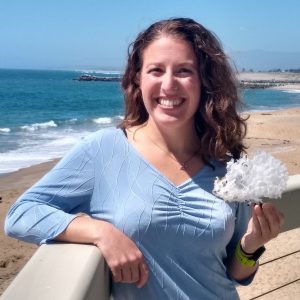Amanda Kahn
Faculty Member
Department: Invertebrate Ecology
Website: https://mlml.sjsu.edu/invertebrate-ecology/
Contact:
email: amanda.kahn@sjsu.edu
phone: (831) 771-4426
office: 411 MLML Main Lab
Biography:
Amanda studies feeding and energetics of suspension feeders from shallow water to the deep sea at both the ecological and organismal scale. She does this to understand the effects of animals’ activity on their surroundings (benthic-pelagic coupling) and the potential effects of human activity on them. Since benthic suspension feeders can be foundation species in their communities, changes to their populations can have ripple effects throughout the community. They may therefore be useful indicators for monitoring changes in habitats.
The invertebrate ecology lab is an integrative lab that combines ship-based, field, and laboratory studies to understand how invertebrates interact with, affect, and are affected by their surrounding environment. Research topics include morphological studies of feeding structures and invertebrate anatomy, in situ and laboratory measurements of metabolic rates, diet studies, and assessments of the effectiveness of marine protected areas on benthic invertebrate species.
Research Interests:
- The effect of suspension feeders on local nutrient cycling (carbon, nitrogen, and silicon) in shallow and deep-sea habitats
- Feeding selectivity, niche partitioning, and specialization of suspension feeders
- Determine effective design of marine protected areas for benthic invertebrate species
- The mechanism behind the ‘sponge loop’ and its ability to shunt microbial carbon into animal food webs
- Using novel visualization methods to determine whether dissolved organic carbon can be taken up directly by animal cells
- Drivers of behavior and activity of sessile benthic animals in shallow water and the deep sea
- Ecological energetics of deep-sea habitats
- Energetic costs of various physiological processes
- Prevalence and selectivity of microplastic ingestion by suspension feeders
Curriculum Vitae:
Selected Publications
- Leys, S.P., E. Matveev, P. Aragonés Suarez, A.S. Kahn, S. Saeed Asadzadeh, T. Kiørboe, P.S. Larsen, J.H. Walther, G. Yahel (2022). Matters Arising ‘Models of flow through sponges must consider the sponge tissue’. Nature, 603: E23–E25. doi: 10.1038/s41586-021-04380-8
- Starr, R., J. Caselle, A.S. Kahn, A. Lauermann, J. Lindholm, B. Tissot, S. Ziegler, C. Bretz, P. Carlson, K. Cieri, J. Hoeke, C. Jainese, G. Martel, S. McDermott, J. Mohay, and P. Salinas-Ruiz (2022). Monitoring and evaluation of mid-depth rock ecosystems in the California MLPA Marine Protected Area network. Report to the Ocean Protection Council, Project R/MPA-48. January 2022. 145 pp.
- Archer, S.K., A.S. Kahn, M. Thiess, L. Law, S.P. Leys, S.C. Johannessen, C.A. Layman, L. Burke, and A. Dunham (2020). Foundation species abundance influences food web topology on glass sponge reefs. Frontiers in Ecology and Evolution, 7: 799. doi: 10.3389/fmars.2020.549478.
- Saxena S., Heller P., Kahn A.S., and Aiello I. (2020). Poriferal Vision: classifying benthic sponge spicules to assess historical impacts of marine climate change. In: Helic D, Leitner G, Stettinger M, Felfernig A, Raś ZW (eds) Foundations of Intelligent Systems. Proc International Symposium on Methodologies for Intelligent Systems. Springer, Cham. Vol 121117:205-213. doi: 10.1007/978-3-030-59491-6_19.
- Law, L.K., H.M. Reiswig, B.S. Ott, N. McDaniel, A.S. Kahn, K.C. Guillas, C. Dinn, and S.P. Leys (2020). Description and distribution of Desmacella hyalina sp. nov. (Porifera, Desmacellidae), a new cryptic demosponge in glass sponge reefs from the western coast of Canada. Marine Biodiversity, 50(4):1-20. doi: 10.1007/s12526-020-01076-6. Preprint, Data
- Kahn, A.S., C.W. Pennelly, P.R. McGill, and S.P. Leys (2020). Behaviors of sessile benthic animals in the abyssal northeast Pacific Ocean. Deep Sea Research Part II: Topical Studies in Oceanography, 173:104729, doi: 10.1016/j.dsr2.2019.104729. Data
Guillas, K.C., A.S. Kahn, N. Grant, S.K. Archer, A. Dunham, and S.P. Leys (2019). Settlement of juvenile glass sponges and other invertebrate cryptofauna on the Hecate Strait glass sponge reefs. Submitted to Invertebrate Biology, 138(4):e12266, doi: 10.1111/ivb.12266. - Grant, N., E. Matveev, A.S. Kahn, S.K. Archer, A. Dunham, R. Bannister, D. Eerkes-Medrano, and S.P. Leys (2019). Effect of suspended sediments on the pumping rates of three species of glass sponge in situ. Marine Ecology Progress Series, 615:79-101.
- Leys, S.P., and A.S. Kahn (2018). Oxygen and the energetic requirements of the first multicellular animals. Integrative and Comparative Biology, icy051. doi: 10.1093/icb/icy051.
- Kahn, A. S., J.W.F. Chu, and S.P. Leys (2018). Trophic ecology of glass sponge reefs in the Strait of Georgia, British Columbia. Scientific Reports 8:756, doi: 10.1038/s41598-017-19107-x.
- Leys, S.P., A.S. Kahn, J.K.H. Fang, T. Kutti, and R. Bannister (2017). Phagocytosis of microbial symbionts balances the carbon and nitrogen budget for the deep-water boreal sponge Geodia barretti. Limnology and Oceanography, 63: 187-202, doi:10.1002/lno.10623.
- Kahn, A.S., and S.P. Leys (2017). Spicule and flagellated chamber formation in a growth zone of Aphrocallistes vastus (Porifera; Hexactinellida). Invertebrate Biology, 136(1): 22-30.
- Kahn, A.S., and S.P. Leys (2016). The role of cell replacement in benthic-pelagic coupling by suspension feeders. Royal Society Open Science 3(11), 160484, doi: 10.1098/rsos.160484.
- Kahn, A.S., L. Vehring, R.R. Brown, and S.P. Leys (2016). Dynamic change, recruitment, and resilience in reef-forming glass sponges. Journal of the Marine Biological Association of the United Kingdom, 96(2):429-436.
- Kahn, A.S., G. Yahel, V. Tunnicliffe, and S.P. Leys (2015). Benthic grazing by deep-water glass sponge reefs. Limnology and Oceanography, 60(1):78-88.
- Kahn, A.S., H.A. Ruhl, and K.L. Smith, Jr. (2012). Temporal changes in plate sponge populations in the abyssal northeast Pacific. Deep-Sea Research Part I, 70:36-41.


